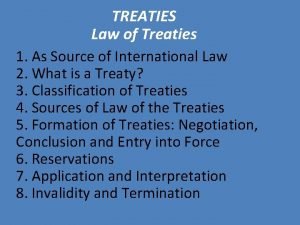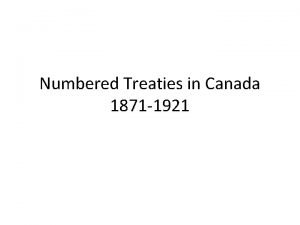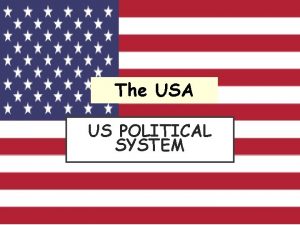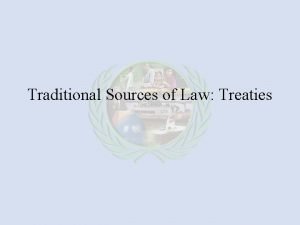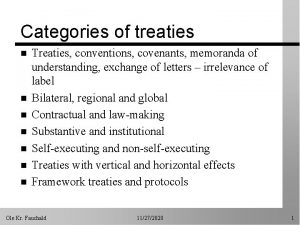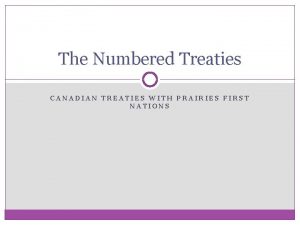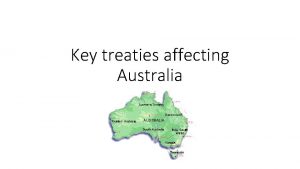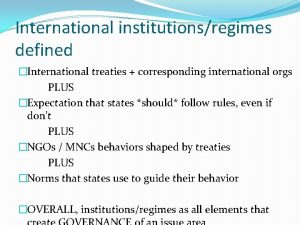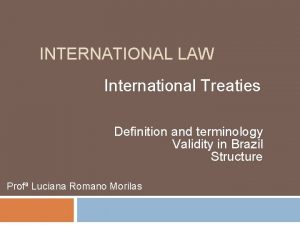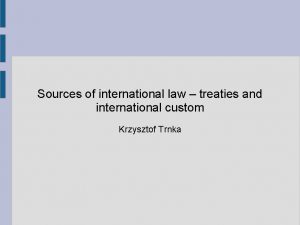International Law Class 3 The Law of Treaties
















- Slides: 16

International Law Class 3 The Law of Treaties Case study: the EVFTA 1

Class 3 • Content: – The law of treaties – What’s a treaty – The Vienna Convention regulation • Sources: – Vienna Convention on the Law of Treaties 1969 – The EU Vietnam Free Trade Agreement 2

The Law of Treaties • Body of IL dealing with the procedural and substantive rules governing the use of treaties as a source of int’l law • It includes many rules on: entry into force, termination, interpretation, reservations and relationship of treaty law with custom • One of the least political areas of IL (need for certainty and clarity) • Same set of rules for all types of treaties • But flexibility for parties to modify, restrict, enhance or exclude the standard rules of the law of treaties 3

Two Basic Principles of the Law of Treaties • Treaties need to be based on free consent of States (consent to be bound) • Freedom of States is not unlimited: once consent to be bound has been expressed and the treaty has entered into force, Art. 26 applies – The treaty shall be respected by the parties in good faith (pacta sunt servanda) – Contrary domestic law is not an excluse for lack of performance 4

What Is A Treaty? / 1 • Treaty = legally binding agreement deliberately created by, and between, two or more subjects of IL with treaty-making capacity • It is governed by international law • Can be entered into by States and international organizations (e. g. , UN Headquarters Agreement btw the UN and the USA, 1947) • Form: Oral, written in a single or several instruments 5

What Is A Treaty / 2 • Procedure: – – – Deliberation of an international conference Direct bilateral negotiations Informal governmental discussions Exchange of notes Exchange of letters Any other means the parties choose • The Vienna Convention does not define what is a treaty • Nomenclature: covenant, convention, charter, statute, act, protocol, exchange of notes, memorandum of agreement/understanding • No need for consideration 6

Acts Lacking Intention to Create Legally Binding Relations • Vital precondition to the formation of treaties: the parties must have intended to create rights and obligation – IL does not regulate any set of form for rights and obligations’ creation • Registration/lack of registration under Article 102 of the Charter: which value? • http: //untreaty. un. org • http: //legal. un. org/avl/ls/Rosenboom_LT_video_2 e. html • Memoranda of understanding and other “political agreements”: flexibility, circumvention of Parliamentary 7 controls

Authority to Enter Into Treaties / 1 • Article 6: Every State possesses capacity to conclude treaties • National law decides which government official or entity is competent to enter into international treaties on the State’s behalf – Breach to such national law is not a ground of invalidity of the treaty unless: – (1) The violation was manifest (= “objectively evident to any State conducting itself in accordance with normal practice”), and – (2) It concerned a rule of domestic law of fundamental importance (Art. 46; see also Art. 27) 8

Authority to Enter Into Treaties / 2 • Article 8: A treaty made by a person not authorised under Article 7 is “without legal effect” • … unless afterwards confirmed by the State 9

Consent to Be Bound • Conditions for a treaty to be legally binding: – (1) The State must have given its consent to be bound – (2) The treay must have entered into force (distinction signature-consent / entry into force) • Consent (Article 11): – Expressed by signature, exchange of instruments constituting a treaty, ratification, acceptance, approval or accession – … or any other means if so agreed 10

Signature / Ratification • Ratification: process whereby a State finally confirms that it intends to be bound by a treaty that it has previously signed • Definitive / Simple signature: the latter is subject to ratification, the former is more likely for bilateral treaties or treaties with only a few parties (cf. Art. 12) • Consent is not effective until such ratification – The treaty itself usually indicates whether signature or ratification if the appropriate mode of consent – If the treaty is silent, one should interpret the parties’ intention (but need for ratification is presumed) – unless the State representative declares that signature is subject to ratification • Usually treaties provide for the steps of consent 11

Entry Into Force • Article 24 • (1) A treaty enters into force “in such manner and upon such date as it may provide or as the negotiating States may agree” • (2) If the treaty is silent, it enters into force as soon as consent to be bound has been established for all the negotiating States 12

Treaties and Third States • Articles 34, 35 and 36 of the Vienna Convention • Treaties are binding only on the parties • Sometimes the parties to a treaty may intend to confer rights or obligations on non-parties without them becoming parties (a matter of interpretation in the light of the circumstances) – In such case, the obligation becomes binding on third party only if it accepts it in writing – In case of right, it is presumed that the third State has accepted unless the contrary is indicated – In both cases, consent is at the root of the transfer of the treaty provisions to the third party 13

Treaties and Third States • So-called dispositive treaties (= they create legal regimes valid for the whole world, erga omnes) – Treaties on territorial matters such as delimitation of boundaries, int’l waterways, territorial status – Treaties constituting int’l organizations (they create an entity with legal personality, opposable to members and non-members alike) • Third parties cannot dispute the objective validity of the state of affairs created by the treaty 14

Inconsistent Treaties • Article 59 • Same subject matter, all same parties: the prior treaty must be regarded as terminated • Article 103 of the UN Charter (see also Art. 30. 1 of the Vienna Convention) • Jus cogens rules and their effect on treaties 15

Case study: the EVFTA Negotiations (who negotiated? ) Status (is it signed? ) What are the procedures to enter into force? What are the main problems for its entry into force? • What happens in case of conflict between the parties? (and how to interpret it? ) • Are there any other mechanisms to settle disputes? • What rights individuals have from the agreement? • • 16
 Termination of treaties
Termination of treaties Numbered treaties
Numbered treaties The usa
The usa What branch of the government makes treaties
What branch of the government makes treaties Peace and friendship treaties
Peace and friendship treaties Numbered treaties worksheet
Numbered treaties worksheet Treaties of velasco
Treaties of velasco Hình ảnh bộ gõ cơ thể búng tay
Hình ảnh bộ gõ cơ thể búng tay Ng-html
Ng-html Bổ thể
Bổ thể Tỉ lệ cơ thể trẻ em
Tỉ lệ cơ thể trẻ em Voi kéo gỗ như thế nào
Voi kéo gỗ như thế nào Tư thế worm breton
Tư thế worm breton Hát lên người ơi
Hát lên người ơi Môn thể thao bắt đầu bằng từ chạy
Môn thể thao bắt đầu bằng từ chạy Thế nào là hệ số cao nhất
Thế nào là hệ số cao nhất Các châu lục và đại dương trên thế giới
Các châu lục và đại dương trên thế giới
